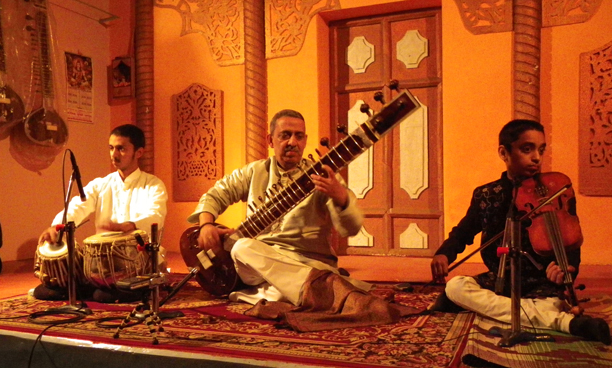
Described as the world’s oldest living city, Varanasi is also believed to be the home of the sitar and tabla – which was precisely what the GE-OS team went there to record.
A private concert in a local music hall served a challenging recording exercise and also an introduction to the complexities of Indian music. On stage was renowned sitar player and teacher Dr Birendra Nath Mishra, accompanied by his sons Abishek on tabla and Prashantha on violin. ‘Anyone who says that musical talent cannot be inherited would eat their words after hearing this trio,’ said team leader Greg Simmons.
The GE-OS Project update #07
2 January 2011
Due to the relatively high level of extraneous noise entering the music hall from passing traffic, the team chose to make a close-miked multitrack recording. A DPA 4041 large-diaphragm omnidirectional condenser was used to capture the sitar, placed approximately 20cm from the tabkadi (soundboard) and pointed diagonally upwards at the jawari (the bone plate that forms the top of the main bridge) – a counter-intuitive placement that yields excellent results and is favoured by many Indian sound engineers and musicians.
Another 4041 captured the tabla, initially placed approximately 25cm above the centre of the two drums but then moved slightly towards the bayan (larger drum, played with the left hand) to achieve the best balance. It was also oriented slightly in front of the bayan and angled so that its on-axis high frequency boost focused on the point where the hand/fingers impacted on the skin. This allowed it to capture the bayan’s articulation in the same tonal context as the siddha (smaller drum, played with the right hand), without the hand itself becoming an obstacle to high frequencies. ‘Close-miking the tabla is never easy’, commented team leader Greg Simmons. ‘Some engineers place a mic on each drum, opting for control, but to my ears that approach is invariably plagued with comb filtering that ruins the multitude of tonalities the tabla produces. Besides, only the most arrogant of sound engineers would assume he or she could balance the siddha and bayan better than the musician does during the performance! For those reasons, I always prefer to use a single microphone position.’
The violin was the softest of the three instruments on stage and yet required the most distant microphone placement to sound natural. A DPA 4023 compact cardioid did the job, positioned approximately 30cm in front of where the bow rubs the strings to capture articulation without suffering proximity effect, and oriented to minimise the level of spill from the sitar and tabla.
A stereo pair should have been placed in the room to provide the all-important ambience for the close-miked sounds, but an intermittent fault with the HHB PortaDrive caused a loss of set-up time and the decision was made to get on with the performance. An acceptable multitrack recording was achieved nonetheless, and the quick mixes have proved promising. Happily, the individual sounds and the overall quality of musicianship are good enough to detract all but the most critical listener from the recording’s inadequacies…
About The GE-OS Project
Founded by Greg Simmons in 2008, The GE-OS Project takes audio students and other interested parties on international recording expeditions to capture the sounds and music of different countries and cultures. The goal is to make the highest quality recordings under the circumstances, with an emphasis on the educational aspects of recording on location.
‘GE-OS’ is an acronym for ‘Guerrilla Ethnomusicology – Open Source’, a reflection of the recording philosophies and dissemination methods used by the project. The recordings fall into three broad categories: direct-to-stereo ethnographic recordings of traditional music performed in traditional contexts, multitrack recordings of local musicians improvising over backing tracks, and phonographic recordings of city sounds, village sounds and nature sounds. On completion of the project, all recordings will be placed on line for anyone to access and use under the terms of a Creative Commons licensing scheme.
The GE-OS Project is currently undertaking its third extended recording expedition and gratefully acknowledges the ongoing support of Amber Technology, DPA Microphones and TC Electronic












